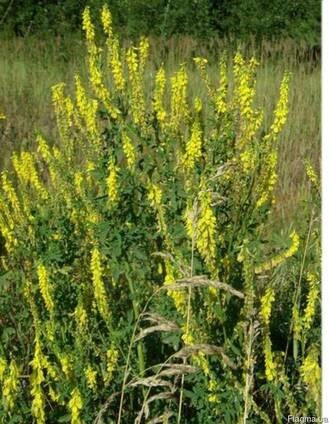Area
Grows on roadsides, meadows, fields. It is mainly found in Ukraine, Belarus, Moldova, the Baltic states, the European part of Russia, western Siberia, the Caucasus and Central Asia.
Botanical description of the plant
Medicinal butterbur (yellow fever) - legumes - belongs to the family Fabaceae. A biennial herbaceous plant, reaching a height of 50-100 cm (sometimes 2 m). The root is branched, bullet root. The stems are single or several, several-sided, the upper part is branched. The leaf is a complex leaf with three plates, arranged in series with the base band. The leaves are inverted egg-shaped, ovoid or oblong-lanceolate, straight-edged or small saw-shaped-toothed and hairless, 3 cm long. The leaf has thin, flat-edged extra leaves. The flowers are small, yellow, clustered in clusters. The inflorescence is cut in half into 5 triangular lanceolate pieces. The inflorescence is typical of butterfly flowers. There are 10 fathers, one of whom is not united, the rest are united. The maternal node is a one-room, upstairs. Fruit - ovoid, transverse, gray, hairless, single-seeded pods. It blooms in June-September, and the seeds ripen from August.

Medicinal properties
The medicinal properties of the product are used as a emollient to treat wounds (when absorbing pus). Dicumarol has a blood-thinning effect, which is 1000-5000 times stronger than coumarin. Therefore, dicumarol is used as an anticoagulant (anticoagulant). Ointment made from the product. The product is part of emollients - teas. In medicine, along with the medicinal sagebrush, tall (tall) sagebrush - Melilotus altissimus Thuill (a biennial plant up to 1.5 m tall, found in the southwestern part of the former Itti-foq and the Altai Territory) and fragrant sagebrush - Melilotus suave . (found in lands where medicinal herbs are grown) are also used.
Growing technology
In Kashgar, medicinal plants play an important role in agriculture. All Uzbek-toned, grows in soils. The plant is very resistant to drought, cold and salinity. As it belongs to the legume family in Kashgar, it enriches the soil with biological nitrogen. When planted in saline soils, it reduces groundwater and reduces salinity. It is also a honey-producing plant. In Kashgar, it is a biennial plant, reaching a height of 75-200 cm. Kashgar-alfalfa is used in food and pharmacology as a medicinal plant. Its fragrant coumarin is obtained from its flowers and fruits. Lands for planting are plowed to a depth of 25-28 cm in the fall and fed with 50-60 kg of superphosphate fertilizer. Kashgarbeda is propagated by seeds in autumn or early spring. It can be planted in areas free from various plants. Seeds are sown that meet the state standards in terms of quality. The seeds are sown in early spring in a grain sowing machine, which consumes 20-25 kg of seeds per hectare. Planting depth should not exceed 2–3 cm. It is often planted in combination with alfalfa-covering crops. Its growth period lasts 85-140 days. Planted in the spring, the plant will germinate in 5–6 days. Grows rapidly during the mating season, the daily growth is 3-5 cm. Growth begins in early spring. Flowering period lasts 14-15 days. The fruit is shed when ripe. Mineral nitrogen is not used much in Kashgar, because it accumulates nitrogen. Therefore, more phosphorus and potassium fertilizers are required. During the initial development, its need for phosphorus is high. If phosphorus is sufficient during this period, it will develop well in later periods as well. The effect of potassium is less than that of phosphorus. Therefore, it gives good results when used together. Depending on the type, fertility and mechanical composition of Kashgar-alfalfa soils, it is recommended to use 90-110 kg of phosphorus and 50-60 kg of potassium during the growing season. When these fertilizers are added to organic fertilizers and two parts are given before planting and after the first harvest, its development is accelerated and yields are higher. If the soil does not have enough nitrogen, it is recommended to apply 40-50 kg of nitrogen fertilizer before planting, if its fertility is low. The use of micro-fertilizers (molybdenum, barium and manganese) in the growth and development of Kashgarbeda is also advisable. Micronutrients are mixed with other mineral fertilizers and seeds. Kashgarbeda fertilization should be done before irrigation.





